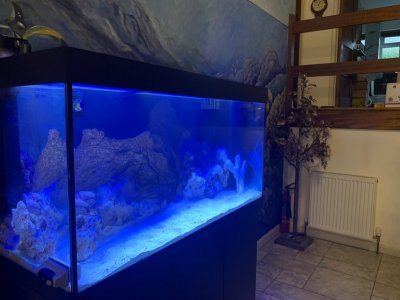I have just set up a smallish fish only marine tank - the Juwel Rio 350, as the name implies, capacity is 350 litres. I fitted it out with an under gravel filter covered with coral gravel/ crushed shell, 40 lbs. of coral sand, rock decoration - oh and the ‘optional’ protein skimmer which, being a Juwel accessory is large and clumsy, 23kg of inert rock, a few kilos of TMC replica living rock and a sea fan that I have had for at least 40 years and then I measured the water capacity when I filled it up - the total was 222 litres - 48UK ( imperial) gallons. That is 128 litres (28 UK gallons) less than the empty capacity. Obviously this affects stocking capacity and certainly influences medication dosage. Not quite as simple a comparison as rock, sand and protein skimmers all absorb medication, so you still need to keep an eye on copper levels etc. Just shows how much capacity is reduced.




















